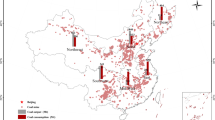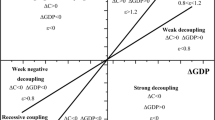Abstract
To begin with, the gravity model is used to study the spatial distribution and centers of gravity for energy-related CO2 emission at regional level and to determine how they have changed over the period 1995–2010 in this paper. Furthermore, the occurrence of a decoupling of each province region between economic activity and CO2 emission from energy consumption is examined based on decoupling index method. The main results are as follows: (1) In 1995, there were only seven provinces, each province of which emitted more than 150 Mt CO2. However, there were 25 provinces and each province’s CO2 emission was more than 150 Mt in 2010. (2) In terms of the annual growth speed of CO2 emission, Neimenggu was the fastest. (3) During the study period, the centers of gravity for CO2 emission are an overall movement toward southwest. (4) During the study period, the decoupling index for 23 provincial regions firstly increased and then decreased; there were six provincial regions whose decoupling index increased continuously; however, the decoupling index for Tianjin firstly decreased and then increased.




Similar content being viewed by others
References
Ang JB (2009) CO2 emissions, research and technology transfer in China. Ecol Econ 68(10):2658–2665
CESY (China Energy Statistical Yearbook) (1997, 2000, 2003, 2004, 2005, 2006, 2007, 2008, 2009, 2010, 2011, 2012) National Bureau of Statistics of China, National Development and Reform Commission
Chen XL, Zhou F (2011) Gravity center change in the coastal area of the Pearl River Estuary based on GIS and RS. In: Dai M et al. (eds) Innovative Computing and Information International Conference 2011, Part II, Communications in Computer and Information Science, vol 232, Springer, Berlin, p 281–286
CSY (China Statistical Yearbook) (2011) National Bureau of Statistics of China
Diakoulaki D, Mandaraka M (2007) Decomposition analysis for assessing the progress in decoupling industrial growth from CO2 emissions in the EU manufacturing sector. Energy Econ 29:636–664
Duan XJ, Wang SG, Chen W (2008) Evolution of population distribution and growth shift in Changjiang River Delta. Sci Geogr Sin 28(2):139–144
Feng KS, Hubacek K, Guan DB (2009) Lifestyles, technology and CO2 emissions in China: a regional comparative analysis. Ecol Econ 69:145–154
Freitas LC, Kaneko S (2011) Decomposing the decoupling of CO2 emissions and economic growth in Brazil. Ecol Econ 70:1459–1469
Fu J, Gao ZG, Huang LY, Zhang L (2011) The movement route of consumption gravity center of Xinjiang from 1965 to 2009 based on GIS. Proc Earth Planet Sci 2:321–326
He YB, Chen YQ, Tang HJ, Yao YM, Yang P, Chen ZX (2011) Exploring spatial change and gravity center movement for ecosystem services value using a spatially explicit ecosystem services value index and gravity model. Environ Monit Assess 175(1–4):563–571
Hilgard JE (1872) The advance of population in the United States. Scribner’s Mon 4:214–218
IPCC (2006) Greenhouse gas inventory: IPCC guidelines for national greenhouse gas inventories. United Kingdom Meteorological Office, Bracknell
Jalila A, Mahmud SF (2009) Environment Kuznets curve for CO2 emissions: a cointegration analysis for China. Energy Policy 37(12):5167–5172
Jayanthakumaran K, Verma R, Liu Y (2012) CO2 emissions, energy consumption, trade and income: a comparative analysis of China and India. Energy Policy 42:450–460
Kumler MP, Goodchild MF (1992) The population center of Canada—just north of Toronto? In: Janelle DG (ed) Geographical Snapshots of North America. Guilford, NewYork, pp 275–279
Lei M, Ju’e G, Chai J, Zhang ZK (2011) China’s regional CO2 emissions: characteristics, inter-regional transfer and emission reduction policies. Energy Policy 39:6136–6144
Li M (2010) Decomposing the change of CO2 emissions in China: a distance function approach. Ecol Econ 70:77–85
Li HN, Mu HL, Zhang M, Gui SS (2012) Analysis of regional difference on impact factors of China’s energy-elated CO2 emissions. Energy 39:319–326
Liu LC, Fan Y, Wu G, Wei YM (2007) Using LMDI method to analyze the change of China’s industrial CO2 emissions from final fuel use: an empirical analysis. Energy Policy 35:5892–5900
OECD (Organization for Economic Co-operation and Development) (2010) Indicators to measure decoupling of environmental pressure from economic growth. Sustainable development SG/SD (2002) 1/Final. http://www.olis.oecd.org/olis/2002doc.nsf/LinkTo/sg-sd(2002)1-final. Accessed 28 Aug 2010
Peng YX, Lin ZS (2010) Analysis of temporal and spatial evolution of SO2 and industrial dust emissions of energy consumption. J Nat Resour 25(1):52–59
Su B, Ang BW, Low M (2013) Input–output analysis of CO2 emissions embodied in trade and the driving forces: processing and normal exports. Ecol Econ 88:119–125
Tapio P (2005) Towards a theory of decoupling: degrees of decoupling in the EU and the case of road traffic in Finland between 1970 and 2001. Transp Policy 12:137–151
Vehmas J, Malaska P, Luukkanen J, Kaivo-oja J, Hietanen O, Vinnari M, Ilvonen J (2003) Europe in the global battle of sustainability: rebound strikes back?—advanced sustainability analysis. Turku School of Economics and Business Administration, Series Discussion and Working Papers 7:2003, Turku
Wang C, Chen JN, Zou J (2005) Decomposition of energy-related CO2 emission in China: 1957–2000. Energy 30:73–83
Wang YH, Guo DZ, Zhang HR, Shen BG (2006) Spatial distribution and applications of coal resource potential in China. J Nat Resour 21(2):225–230
Wang QQ, Huang XJ, Chen ZG, Tan D, Chuai XW (2009) Movement of the gravity of carbon emissions per capita and analysis of causes. J Nat Resour 24(5):833–841
Wang R, Liu WJ, Xiao LS, Liu J, Kao W (2011) Path towards achieving of China’s 2020 carbon emission reduction target—a discussion of low-carbon energy policies at province level. Energy Policy 39(5):2740–2747
Wang Q, Yue TX, Wang CL, Fan ZM, Liu XH (2012) Spatial–temporal variations of food provision in China. Proc Environ Sci 13:1933–1945
Wu LB, Kaneko S, Matsuoka S (2005) Driving forces behind the stagnancy of China’s energy-related CO2 emissions from 1996 to 1999: the relative importance of structural change, intensity change and scale change. Energy Policy 33:319–335
Zhang ZX (2000) Decoupling China’s carbon emissions increase from economic growth: an economic analysis and policy. World Dev 28:739–752
Zhang M, Mu HL, Ning YD (2009) Accounting for energy-related CO2 emissions in China, 1991–2006. Energy Policy 37:763–773
Zhang L, Huang Y, Li Y et al (2010) An investigation on spatial changing pattern of CO2 emissions in China. Resour Sci 32(2):211–217
Zhang Y, Zhang JY, Yang ZF, Li J (2012) Analysis of the distribution and evolution of energy supply and demand centers of gravity in China. Energy Policy 49:695–706
Acknowledgments
The authors gratefully acknowledge the financial support from the Fundamental Research Funds for the Central Universities (2013W04), National Natural Science Foundation of China (71403266), Natural Science Foundation of Jiangsu Province (BK20130176), and the China Postdoctoral Science Foundation (2013M541752). We would like to thank the anonymous referees for their helpful suggestions and corrections on the earlier draft of our paper and upon which we have improved the content.
Author information
Authors and Affiliations
Corresponding author
Rights and permissions
About this article
Cite this article
Song, Y., Zhang, M. & Dai, S. Study on China’s energy-related CO2 emission at provincial level. Nat Hazards 77, 89–100 (2015). https://doi.org/10.1007/s11069-014-1580-y
Received:
Accepted:
Published:
Issue Date:
DOI: https://doi.org/10.1007/s11069-014-1580-y




